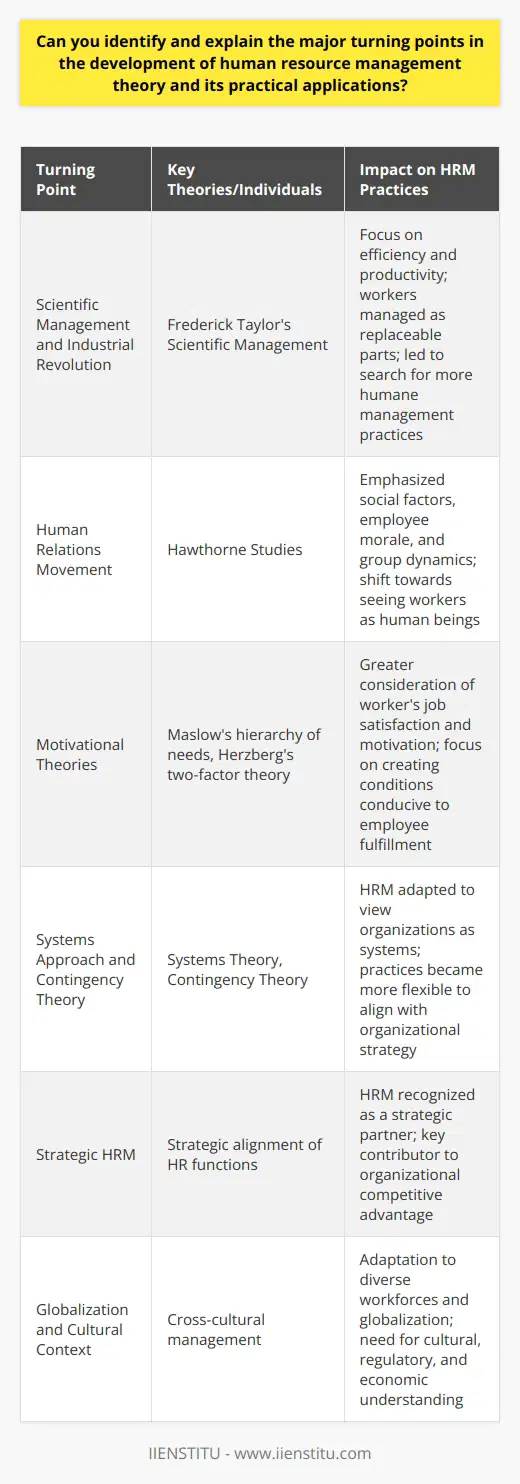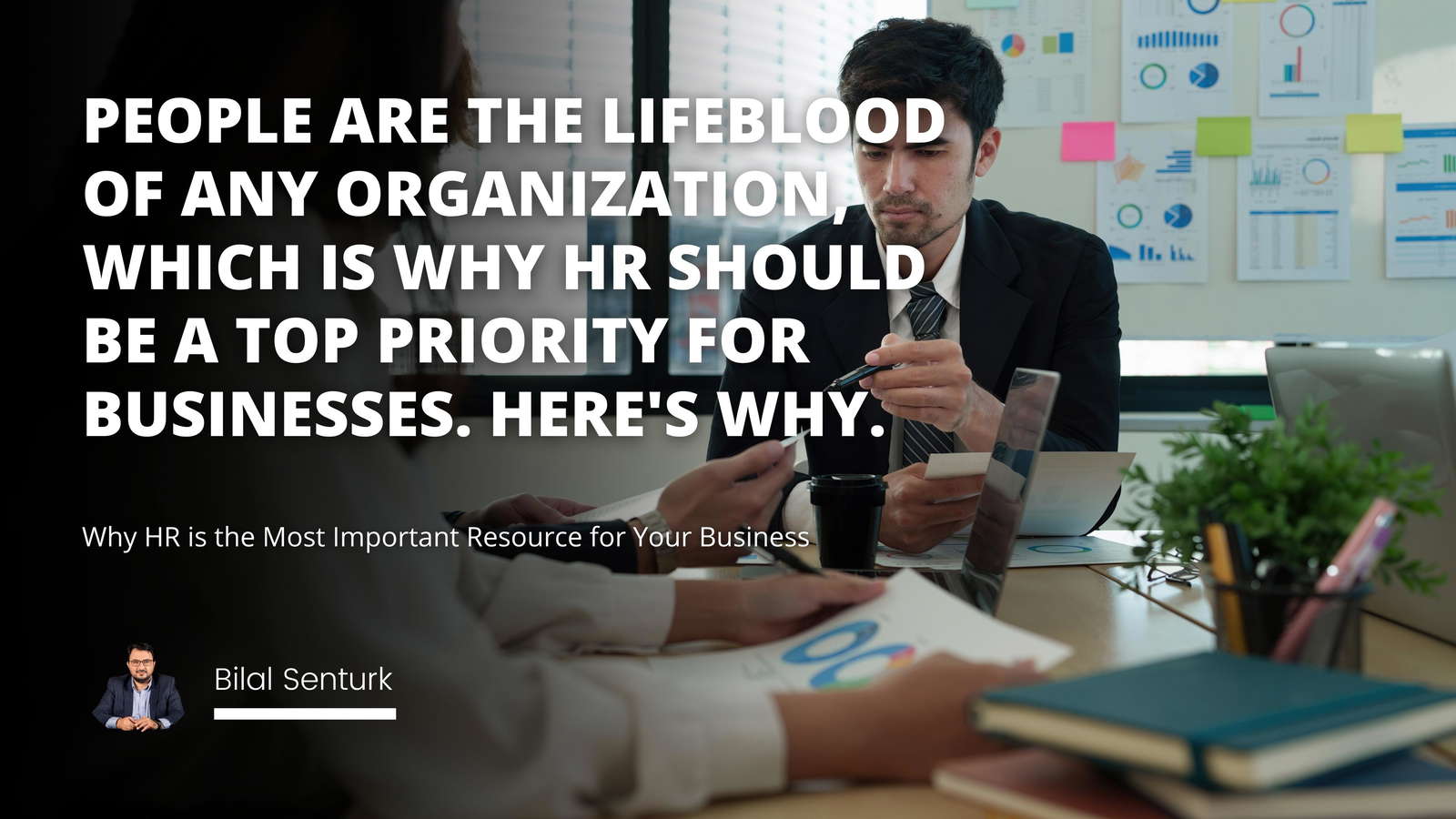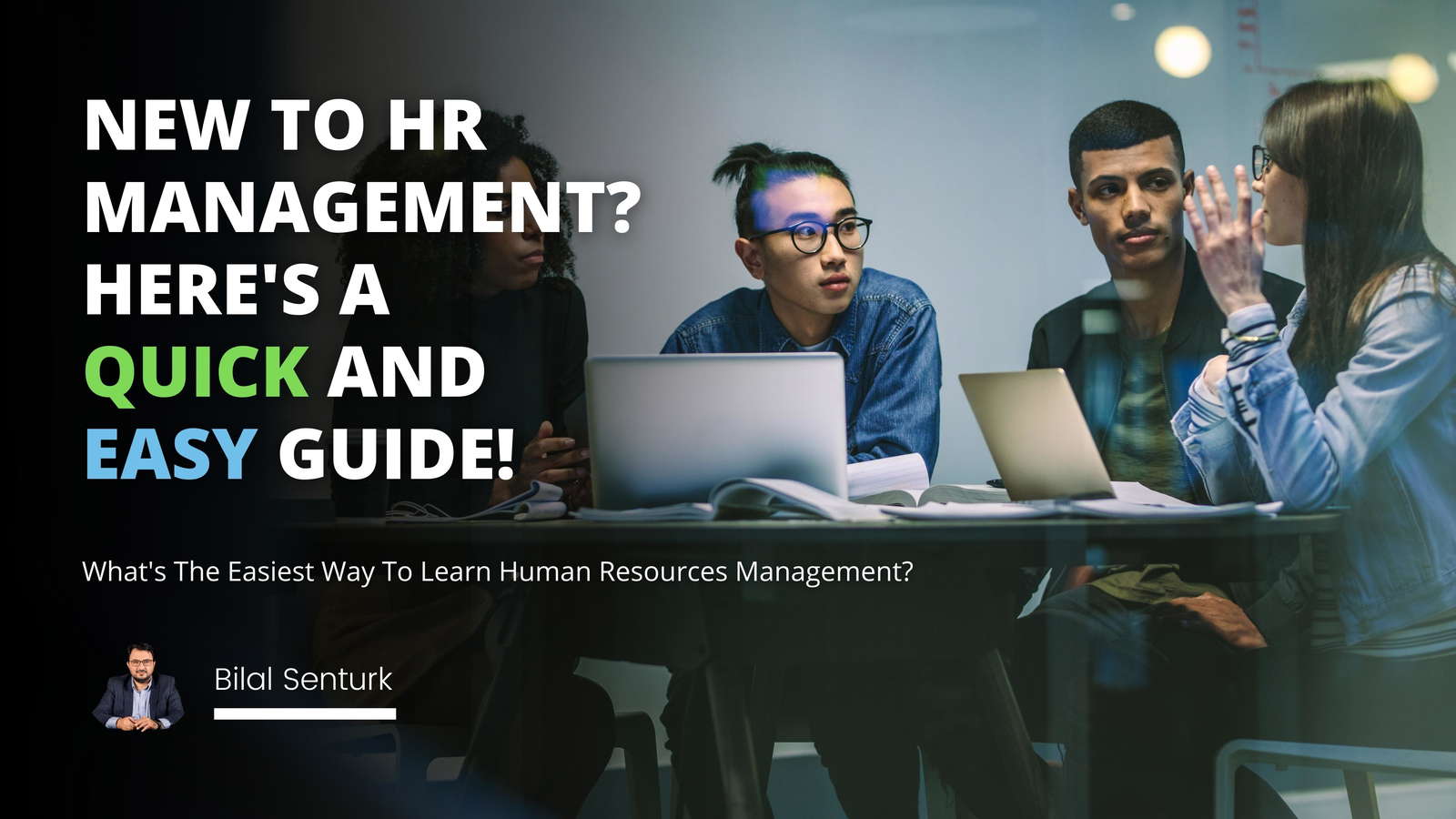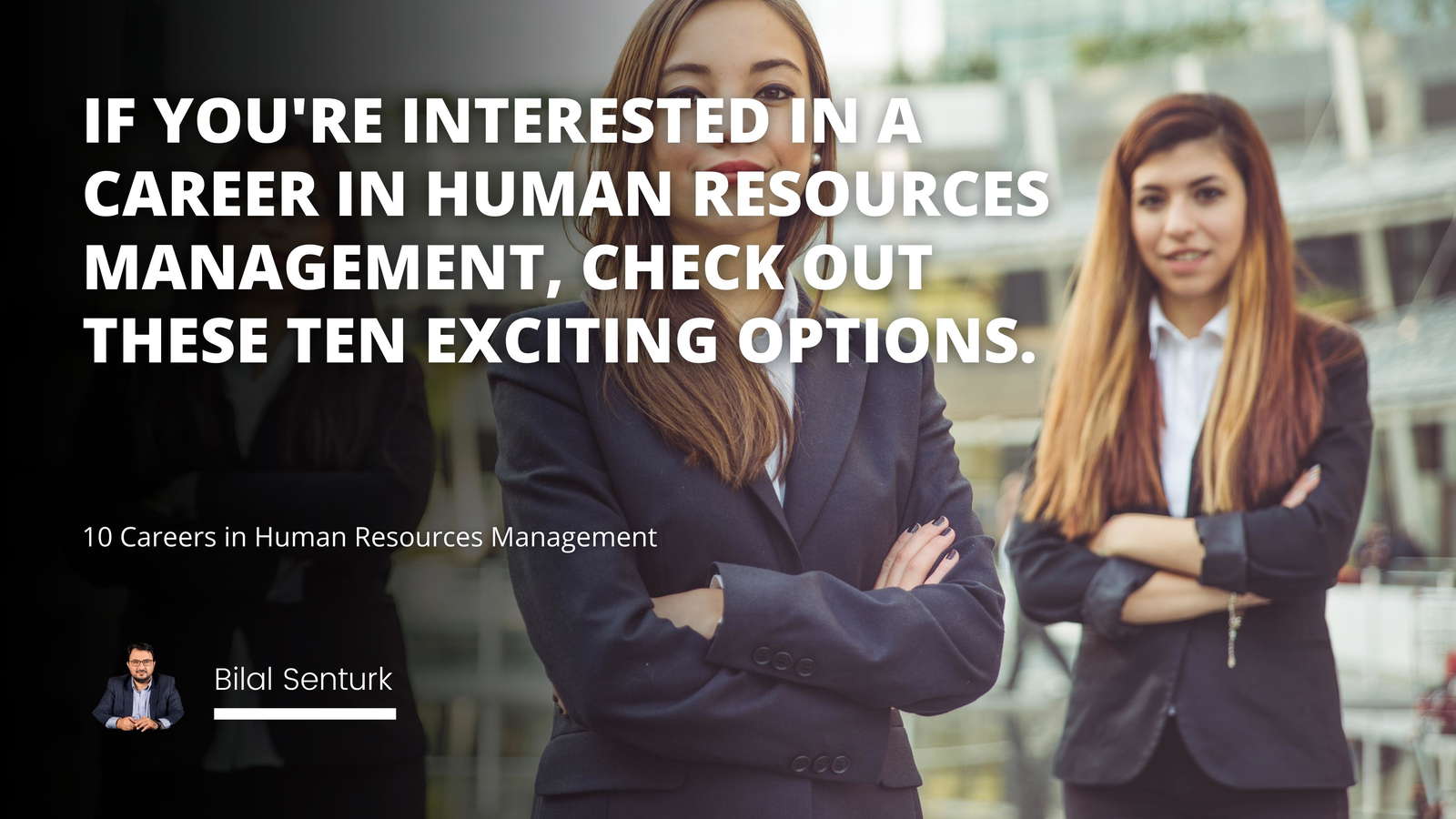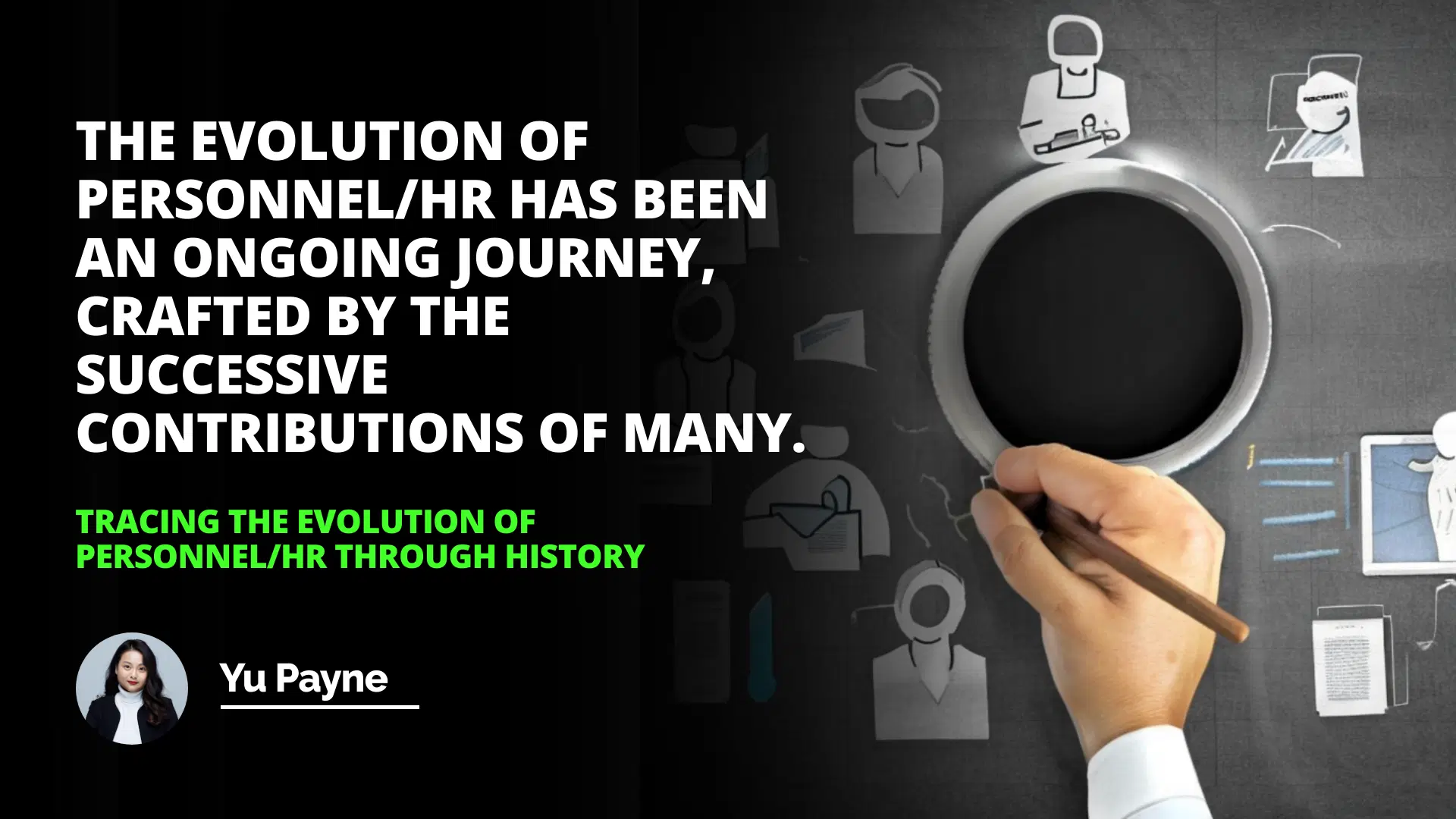
Ancient Origins of Personnel/HR
The Industrial Age & Personnel/HR
Post-Industrial Revolutions & the Development of Modern Personnel/HR
The role of personnel departments in organizations has changed dramatically over the years. It’s interesting to trace the evolution of personnel/HR through history, as it offers insight into the various managerial approaches that have driven the development of HR and personnel management. In this blog post, we’ll look at the ancient origins of personnel and HR, the industrial age and its influence on personnel, and the post-industrial revolutions and the development of modern HR and personnel management
Ancient Origins of Personnel/HR
The earliest origins of personnel date back to the 18th century when the Guilds and Family Officers system in England began to diversify and delegate roles due to expanding operations. A Family Officer, for example, was in charge of accounting and bookkeeping for a company or trade, delegation of tasks, Management of staff, and monitoring of the progress of the work undertaken by employees. This marked the beginning of ‘personnel’ approaches to regulating and managing people in a business.
Effects Of Workplace Discrimination On Organizational Wellness
Most Searched Keyword For Employee Benefits Package Overview
The Industrial Age & Personnel/HR
In the 19th century, the industrial revolution led to significant changes in how personnel and HR operated, with the need for employees to cooperate and coordinate their efforts during such a massive change in the industry. For example, the rapid growth of railway networks led to many businesses recruiting large numbers of staff and developing personnel departments, regulations, and policies to manage this growth.
Flowing from this era, the scientific, or ‘Taylorist’ approach to personnel, also known as ‘Scientific Management,’ began to take hold, most famously associated with the views of Fredrick Winslow Taylor. Scientific Management was focused on technology and efficiency, where personnel departments ensured employees followed strict processes and regulations, with production aimed at maximizing output and minimizing cost while paying little attention to workers’ skills and satisfaction.
Post-Industrial Revolutions & the Development of Modern Personnel/HR
With the decline of the industrial age came a significant shift in thinking, moving away from the Taylorist approach to personnel and HR and towards one that paid more attention to workers’ needs and desires. This shift also brought the dawn of the industrial psychology movement and its ‘human relations’ approach. This focused on finding ways to motivate employees, improve morale and engage staff to concentrate on helping them reach their full potential.
The concept of ‘organizational development’ then emerged, focusing on understanding the needs of businesses through scientifically-founded evidence and research. This encouraged HR departments to increasingly develop as part of operations or business objectives, to look for ways to involve employees and give them a sense of ownership of their roles.
The increasing emergence of computers and technology has also revolutionized personnel administration. Automated processes in place of paperwork and manual data entry, streamlined communication between personnel, employees, and Management, and the addition of analytical data to measure the success of personnel departments have all drastically changed the face of personnel/HR.
Conclusion: The evolution of personnel and HR has come a long way since the days of Guilds and Family Officers, and the advances brought upon us by the industrial, post-industrial, and digital ages have revolutionized the way we manage resources, ensure business objectives are met, and manage people in our businesses. Each period has offered new and unique approaches to personnel and HR, and it’s been amazing to see this evolution over the years.
The evolution of personnel has been an ongoing journey crafted by the successive contributions of many.
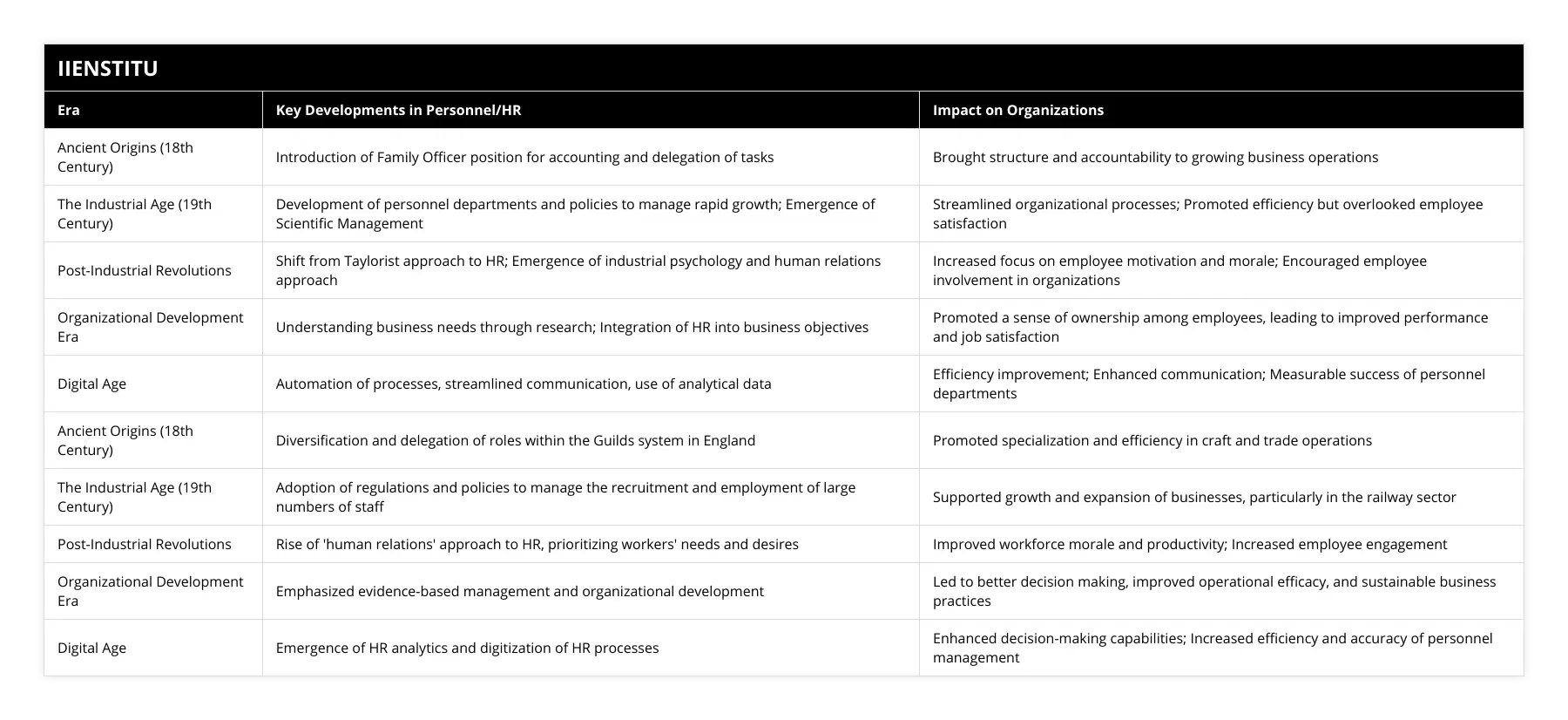
Frequently Asked Questions
What primary sources have been used to trace the evolution of personnel/HR history?
The study of personnel/HR history examines the development of practices, policies, and theories on human resource management over time. To properly trace this evolution, primary sources are invaluable sources of information.
A primary source is a record or document created during the period in which a particular event or phenomenon under investigation occurred. Primary sources include original documents such as personal correspondences, diaries, meeting minutes, newspaper articles, interviews, and official records such as census and taxation records. Using primary sources allows researchers to understand a historical period in-depth.
Personnel/HR history has been used to gain insights into organizational development history, workers' lives, and the changing nature of work itself. Scholars can identify how personnel/HR practices have changed by examining primary sources from various periods. For instance, by reviewing letters from early managers and unions, researchers can identify how negotiations between management and labor were carried out during that period. Similarly, newspaper articles and government records provide insights into how laws were made and amended to protect workers' rights.
One of the most important primary sources for studying personnel/HR history is interview records with crucial figures in the industry. Interviews provide direct access to the perspectives of influential people and can help scholars identify the different strategies used to manage personnel and HR policies. Similarly, historians rely on an array of official records to trace the evolution of personnel/HR history, including personnel/HR policies, reports, and bylaws.
Overall, primary sources are invaluable in understanding the evolution of personnel/HR history. By examining primary sources such as interviews and official records, researchers can gain a deeper understanding of the changing trends in personnel/HR management and the people involved in making them a reality.
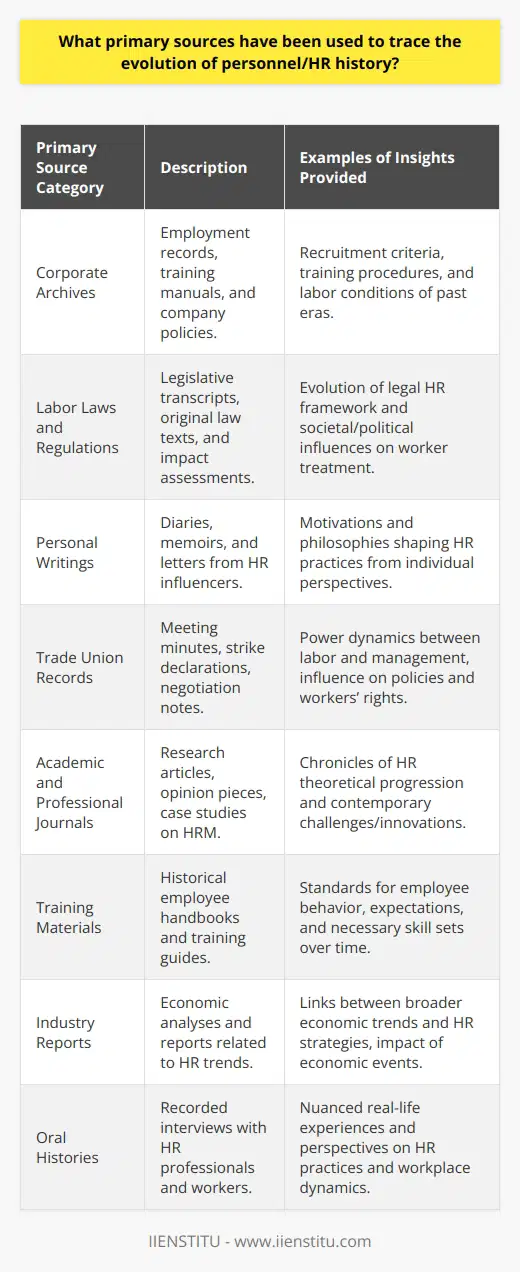
What role have trade unions played in the development of personnel/HR?
Trade unions have played a vital role in developing personnel and HR management, advocating for workers’ rights, and working to ensure that the workplace is fair and equitable for all. Unionized workers have typically been able to use the collective power of the union to negotiate for better working conditions and to improve their wages and benefits packages. This has enabled them to determine their work-life balance and enjoy greater job security, which has made for a more productive, satisfied, and engaged workforce.
Furthermore, the presence of trade unions has encouraged the development of structures to ensure that personnel and HR departments function according to specific standards and procedures. Associations have worked to protect workers from arbitrary management decisions, promoted and facilitated the appropriate handling of personnel issues, and provided the legal framework necessary to sustain workplace harmony. This legal framework includes the right of workers to be represented by a union, the right to collective bargaining, and the right to dispute resolution.
The ability of trade unions to mobilize workers and engage in collective action has led to the emergence and promulgation of labor laws designed to protect workers, promote job security, and ensure a safe and healthy workplace. Such labor laws regularly require employers to provide working conditions that comply with specific minimum standards and that permit workers to be protected against accidental injury or occupational disease caused by hazards inherent to the workplace.
In addition, trade unions have been major players in shaping the modern human resources landscape. For example, unions have worked with organizations to create and implement employee benefits,s including health insurance, paid vacation and personal leave, flexible work arrangements, and disability and pension benefits. Furthermore, trade unions have been instrumental in defining and developing HR policies, including collective bargaining, job satisfaction surveys, and performance evaluations. Lastly, unions have played an essential part in promoting gender equality, diversity, and inclusion in the workplace.
Trade unions have advocated for workers’ rights and contributed to developing structures and processes to ensure safe and equitable workplace environments. In addition, they have shaped the modern human resources landscape, ensuring that personnel/HR departments function according to specific standards and that employee benefit packages are fair and equitable. As such, the role of unions in the field of personnel and HR is of undeniable importance.
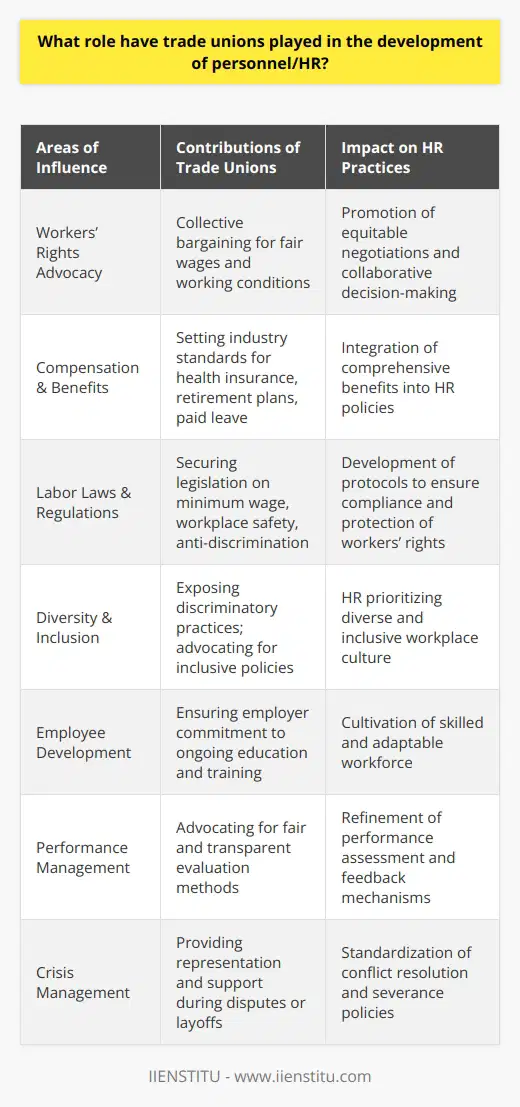
How have industrialization, technological advances, and changing social norms impacted personnel/HR administration practices?
The advent of widespread industrialization and technological advances in our society has tremendously impacted personnel/HR administration practices. As the magnitude of businesses grew, so too did the complexity of personnel and HR practices. Industrialization increased the need for formalized personnel policies, which applied to all companies, to ensure that working conditions were appropriate and that employees were treated fairly. Further, with the rise of technology, businesses can incant several employees more efficiently. Computer databases became available to store employee records, payroll systems to ensure employees were paid accurately and on time, and software programs to schedule shifts and manage the hiring process.
As the economy changed, personnel and HR practices had to adapt to meet the demands of the modern workplace. As automation increased, the need to maintain a highly skilled and specialized workforce grew. Techniques such as performance appraisals, wage and salary management, job analysis, and recruitment and selection had to adopt new methodologies to ensure employers had access to the human capital necessary for its success.
The growth of the service sector and global labor markets has brought challenges related to foreign worker visas, remote working, and multinational company protocols. Further, as the workforce continues to diversify and new social norms emerge, personnel and HR departments must keep abreast of legal regulations to ensure employees’ rights are met and no one is discriminated against based on gender, race, color, age, nationality, religion, or sexual orientation.
With the rise of industrialization, technological advances, and changing social norms, personnel/HR administration practices have had to be flexible enough to adjust to these modern demands. By recognizing these changes and implementing systems and policies to keep up with the times, personnel and HR departments can develop a prepared workforce to be competitive in the modern business landscape.

How has the shift from personnel management to human resource management influenced organizational strategies and practices?
Shift in Focus and Approach
The shift from personnel management to human resource management has significantly influenced organizational strategies and practices. One key impact is the change in focus from transactional activities, such as payroll and benefits administration, to a more strategic and holistic approach to managing people. Human resource management seeks to align people management with an organization's overall mission and objectives, resulting in improved performance and outcomes.
Emphasis on Employee Development
Human resource management places greater emphasis on employee development, including training, performance management, and career planning. Companies now recognize the importance of investing in their employees to develop their talent and enhance their skills, ultimately contributing to organizational success. This change has led to the increased use of talent management systems and employee training programs, as well as a more comprehensive performance appraisal process to identify and address skill gaps.
Workforce Diversity and Inclusion
The evolution of personnel management to human resource management has also led organizations to pay greater attention to workforce diversity and inclusion. Promoting diversity and ensuring equal opportunities is not only ethically sound but also strategically beneficial, as a diverse workforce brings different perspectives and ideas, leading to more innovative and efficient problem-solving. Consequently, organizations have adopted strategies like diversity and inclusion training, implementing unbiased recruitment practices, and setting diversity targets to create a more inclusive work environment.
Employee Engagement and Satisfaction
The importance of employee engagement and satisfaction has become more evident with the rise of human resource management. Organizations have recognized that a motivated, satisfied, and committed workforce is vital for achieving strategic objectives. Consequently, companies have started to prioritize employee well-being by offering better work-life balance options, providing competitive salaries and benefits, and fostering a positive company culture. These efforts aim to boost morale and productivity, ultimately benefitting the organization's bottom line.
In conclusion, the shift from personnel management to human resource management has significantly influenced organizational strategies and practices. It has led to a more strategic and integrated approach to people management, with an emphasis on employee development, workforce diversity and inclusion, and employee engagement and satisfaction. These changes have not only enhanced organizational performance but also contributed to the creation of more inclusive and supportive work environments.

What are the critical milestones in the development of HRM in response to varying global business contexts?
Historical Evolution of HRM
The development of Human Resource Management (HRM) has undergone numerous critical milestones in response to varying global business contexts. The Industrial Revolution marked the initial shift towards more efficient and productive HRM systems, which eventually became essential due to the increase in factory work and the need for skilled labor.
Scientific Management and Human Relations Movement
During the early 20th century, Frederick Taylor's scientific management principles enhanced performance and productivity in the workplace by focusing on employees' specialization and training. The human relations movement, led by Elton Mayo, highlighted the importance of social factors, such as communication and employee morale, in driving workplace productivity even further.
Legislation and Regulation
Over time, HRM became heavily influenced by various legislations and regulations. The Fair Labor Standards Act (FLSA) established minimum wage and overtime provisions, while the Civil Rights Act prohibited employment discrimination based on race, color, religion, sex or national origin. More recently, the Occupational Safety and Health Act (OSHA) reinforced the importance of improving workplace safety and health.
Globalization and Technology
In the late 20th century and early 21st century, HRM shifted focus towards globalization and technology. Companies expanded globally, becoming multinational corporations, and HRM faced new challenges, such as addressing diverse workforce needs, talent acquisition, and retention from a global talent pool. The adoption of technology within HRM also increased, with tools like applicant tracking systems, e-learning platforms, and performance management software streamlining HR processes and decision-making.
Strategic HRM and Business Sustainability
In the last few decades, HRM has evolved from being reactive and administrative to playing a strategic role within organizations. HR professionals started aligning HR strategies with organizational goals, emphasizing talent management, employee engagement, and workforce planning. Additionally, HRM now considers the triple bottom line—focusing on economic, social, and environmental aspects—to ensure sustainable business practices and long-term organizational success.
Conclusion
The development of HRM has been shaped by various critical milestones, reflecting the ever-changing global business context. HRM has evolved from simplistic workforce management to a comprehensive and strategic approach, addressing not only employee-related issues but also aligning HR practices with overall business goals and sustainability. In today's digital age, as technology continues to impact global business dynamics, HRM must remain adaptable and agile to ensure organizational success in an increasingly competitive world.
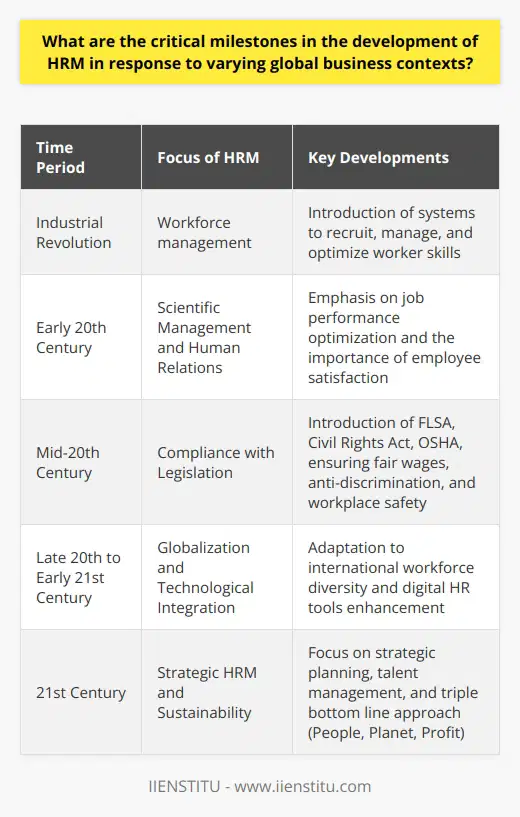
How does the evolution of HRM concepts and theories relate to modern workforce management challenges?
Evolution of HRM Concepts and Theories
The evolution of human resource management (HRM) concepts and theories is intrinsically linked to the rapidly changing landscape of modern workforce management challenges. Over time, emerging ideas on HRM have continually adapted to provide organizations with innovative strategies and tools geared towards addressing pressing employee-related concerns.
From Personnel Management to Strategic HRM
Initially, the focus of HRM primarily revolved around personnel management, which entailed the administrative handling of staffing, payroll, and policy maintenance tasks. However, the growing recognition of HRM as a central organizational function brought forth the development of strategic HRM. This approach not only enhanced the effectiveness of personnel management but also added value to organizations by fostering employee satisfaction and performance.
Emphasis on Employee Engagement and Satisfaction
As organizations grapple with employee retention and an increasingly competitive labor market, HRM theories have evolved to emphasize the importance of cultivating a work environment that promotes employee engagement and satisfaction. The transition from a transactional HRM approach (pay and rewards) to a transformational one (employee development, alignment with organizational goals, and motivation) demonstrates the field's responsiveness to the evolving workforce management landscape.
Diversity, Equity, and Inclusion Initiatives
Modern workforce management is fraught with the challenge of fostering a diverse, equitable, and inclusive environment. As such, contemporary HRM research has focused on understanding the importance of diversity, equity, and inclusion (DEI) initiatives, including best practices for implementing and managing such programs. These studies have greatly informed the policies and practices employed by organizations to counter systemic discrimination and promote inclusivity.
Adaptive HRM in a Globalized World
The rise of globalization, remote work, and the integration of technology into the workforce bring with them unique workforce management challenges. Consequently, HRM concepts and theories have explored patterns of adaptability and flexibility in a globalized, technology-driven labor market. For instance, the development and refinement of virtual teams and the evolution of labor-technology interactions illustrate HRM's sustained commitment to addressing emergent workforce management issues.
Conclusion
In sum, the evolution of HRM concepts and theories has been the driving force behind the field's ability to adapt and manage the multifaceted challenges associated with modern workforce management. By continuously learning from advances in HRM knowledge, organizations can better navigate the complexities of employee engagement, diversity, globalization, and technology disruption, ultimately resulting in improved overall organizational performance.
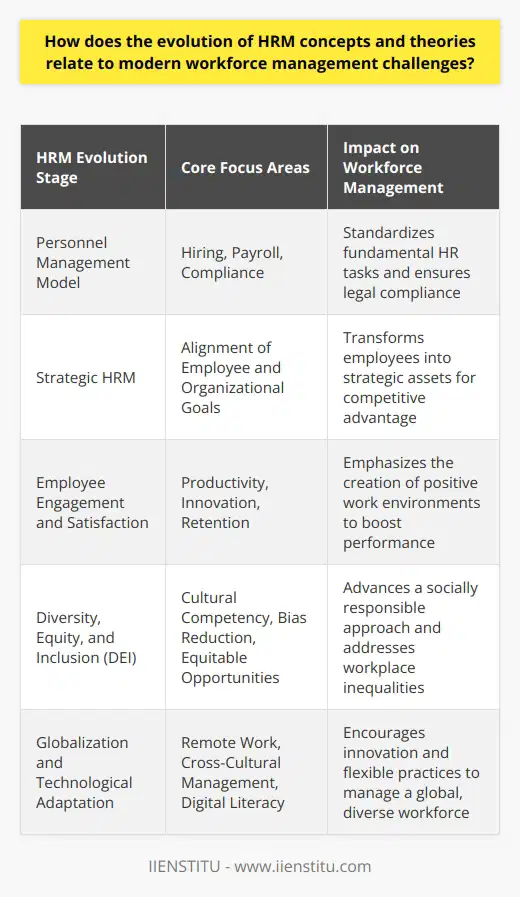
What factors contributed to the emergence of human resource management as a distinct field of practice and study?
Historical Context
One critical factor in the emergence of human resource management (HRM) as a distinct field of practice and study is its historical evolution in response to changing socio-economic conditions. The Industrial Revolution resulted in significant transformations in work processes, which necessitated the management of human capital to achieve organizational goals efficiently.
Organizational Behavior and Psychology Influence
Another essential factor contributing to the development of HRM as a distinct field is the incorporation of organizational behavior and psychology principles in understanding employees. The application of psychological theories and research in employee motivation, job satisfaction, and workplace behavior led to systematic approaches to deal with human resources. This confluence of psychology and management enabled HRM to have unique methodologies and practices.
Legal Environment and Compliance Needs
The legal environment has also played a substantial role in shaping HRM as a distinct field. The implementation of labor laws, workplace safety regulations, and anti-discrimination policies reinforced the need for a formal HR structure within organizations. The growing demands for compliance and employee protection led practitioners and scholars to refine HRM approaches, aligning them with legal requirements.
Shift from Personnel to Strategic Management
Another pivotal factor is the shift from a focus on personnel management to strategic human resource management. While traditional personnel management was mainly concerned with operational tasks such as payroll administration and employee recordkeeping, HRM has evolved into a practice of aligning HR policies with business strategies. This strategic orientation enables organizations to manage employees as valuable assets and leverage their potential to gain a competitive advantage.
Globalization and Cross-Cultural Challenges
Lastly, the impact of globalization on businesses has amplified cross-cultural and diversity challenges faced by organizations. HRM has emerged as a field capable of addressing these issues by developing policies and practices to efficiently manage a diverse workforce, promoting harmony and inclusivity. The study of HRM has thus expanded to encompass global and international HRM as subfields that focus on navigating intercultural complexities.
In summary, the emergence of human resource management as a distinct field of practice and study can be attributed to several factors, including its historical evolution, the incorporation of organizational behavior and psychology principles, a changing legal environment, the shift from personnel to strategic management, and the impact of globalization. These factors have shaped HRM's trajectory, making it an indispensable area of expertise for modern organizations.
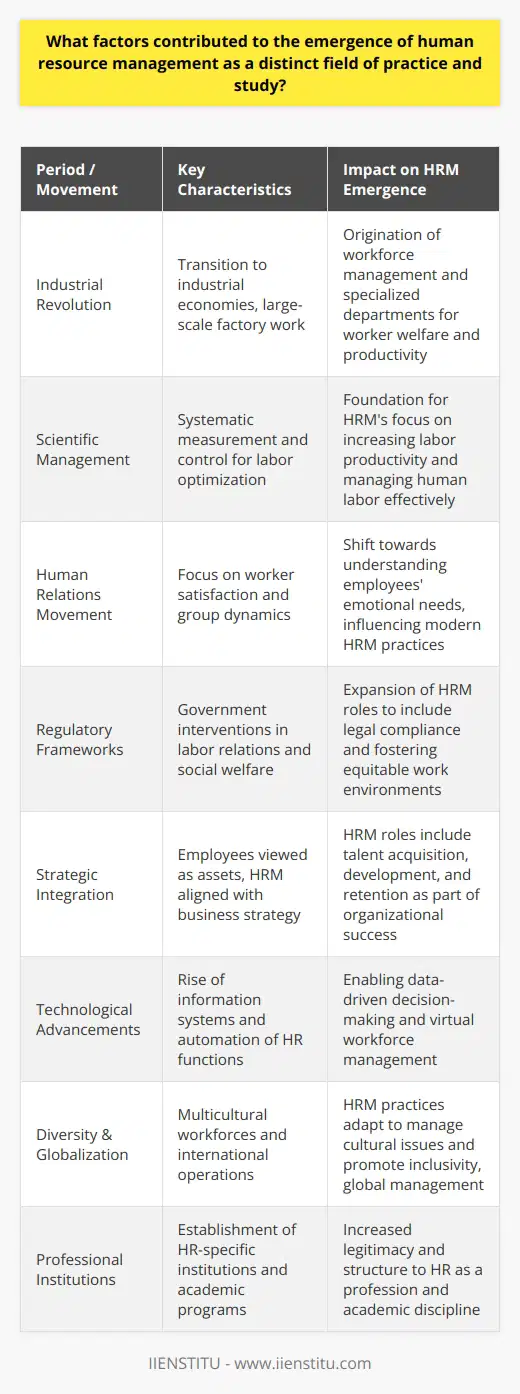
How did the rise of scientific management and the human relations movement influence the evolution of human resource management?
Scientific Management's Impact on HRM
The rise of scientific management played an essential role in shaping the evolution of human resource management (HRM). This management philosophy, developed by Frederick Taylor, sought to improve industrial efficiency through the systematic analysis of work tasks, establishment of standardized procedures, and specialization of labor roles. The objective was to create a more productive and unified workforce. This rational approach to work design served as a precursor to the development of job analysis and performance appraisal techniques that remain central to HRM today. Moreover, scientific management principles laid the groundwork for training and employee development programs, as they emphasized the need for workers to acquire specialized skills to perform particular job functions.
Human Relations Movement and HRM
In response to the increasingly mechanistic nature of work under scientific management, the human relations movement emerged, underscored by the Hawthorne studies conducted by Elton Mayo and his colleagues in the 1920s and 1930s. Contrary to the earlier focus on task optimization, the human relations movement emphasized the social and psychological aspects of work, highlighting the importance of communication, leadership, and interpersonal dynamics. This movement significantly influenced the evolution of HRM by redirecting organizational attention towards the human element – workers' motivations, needs, and emotional well-being – rather than the mere optimization of work processes. Consequently, this shift laid the foundation for the establishment of employee relations, welfare programs, and team-building initiatives in modern HRM.
Integration: The Modern-Day HRM
The integration of scientific management and the human relations movement perspectives led to the development of the contemporary HRM framework that balances the requirements of both organizational efficiency and employee engagement. This integrated approach acknowledges the need for robust work systems, standardization, and specialized training as proposed by scientific management, while simultaneously recognizing the relevance of employees' psychological and social needs as emphasized by the human relations movement. Consequently, the present-day HRM function revolves around managing a comprehensive range of activities that span workforce planning, recruitment and selection, performance management, employee relations, and professional development to ensure organizational success while prioritizing employee welfare.
In conclusion, the rise of scientific management and the human relations movement has been instrumental in shaping the evolution of HRM. These two paradigms contributed to the creation of an employee-centric management approach that merges the technical and human aspects of work. The influence of these movements on HRM is still evident today as modern organizations continue to prioritize both efficiency and employee well-being in their pursuit of success.
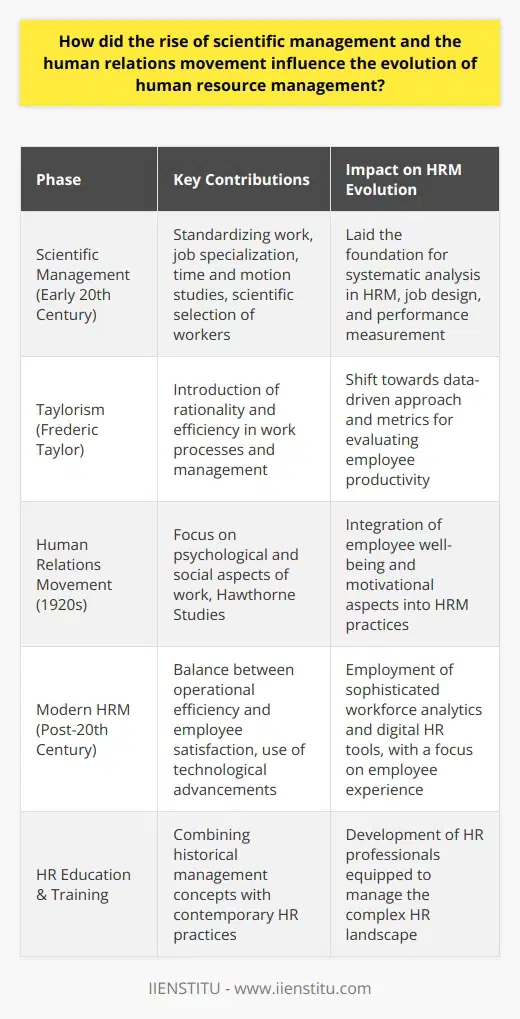
In what ways has the changing legal and regulatory landscape impacted the roles and responsibilities of HR professionals throughout history?
Legal and Regulatory Changes
The legal and regulatory landscape has significantly impacted the roles and responsibilities of HR professionals throughout history by transforming their functions, focus, and expertise.
Employment Laws and Compliance
One key aspect is the emergence of various employment laws, such as equal opportunity, anti-discrimination, and labor protection legislation. These laws require HR professionals to ensure compliance within an organization, creating a necessary focus on legal and ethical standards.
Workplace Health and Safety
The development of workplace health and safety regulations has also shaped the role of HR professionals. They must now oversee the implementation of policies and procedures that minimize workplace hazards and risks, reflecting a shift in their responsibilities from merely managing personnel to ensuring a safe work environment.
Employee Privacy and Data Protection
The increasing importance of data privacy, exemplified by regulations such as the General Data Protection Regulation (GDPR), has expanded the HR professional's role in safeguarding employee information. They are now responsible for developing and implementing data protection strategies that balance organizational needs with legal requirements, which has necessitated a greater emphasis on technology and data management skills.
Organizational Performance and Culture
As organizational culture and performance have become more crucial factors in attracting and retaining employees, HR professionals have been entrusted with the responsibility of cultivating a positive work environment. This has led to an increased focus on employee engagement, talent development, and diversity and inclusion initiatives.
Emerging Workforce Trends
Furthermore, changing workforce trends, such as the gig economy and remote work, have required HR professionals to adapt their strategies for talent acquisition, benefits administration, and performance management. In response to these trends, they have developed more flexible and inclusive policies to accommodate a diverse array of employment arrangements.
International Expansion
Finally, the expansion of organizations into foreign markets has necessitated a global HR perspective. As a result, HR professionals must now navigate complex international labor laws, coordinate with foreign counterparts, and manage cultural differences when developing and implementing HR practices.
In conclusion, the changing legal and regulatory landscape has profoundly impacted the roles and responsibilities of HR professionals throughout history. As a result, they have evolved from primarily administrative personnel managers to strategic business partners who must align their practices with an organization's strategic goals while ensuring compliance with ever-changing legal and ethical requirements.
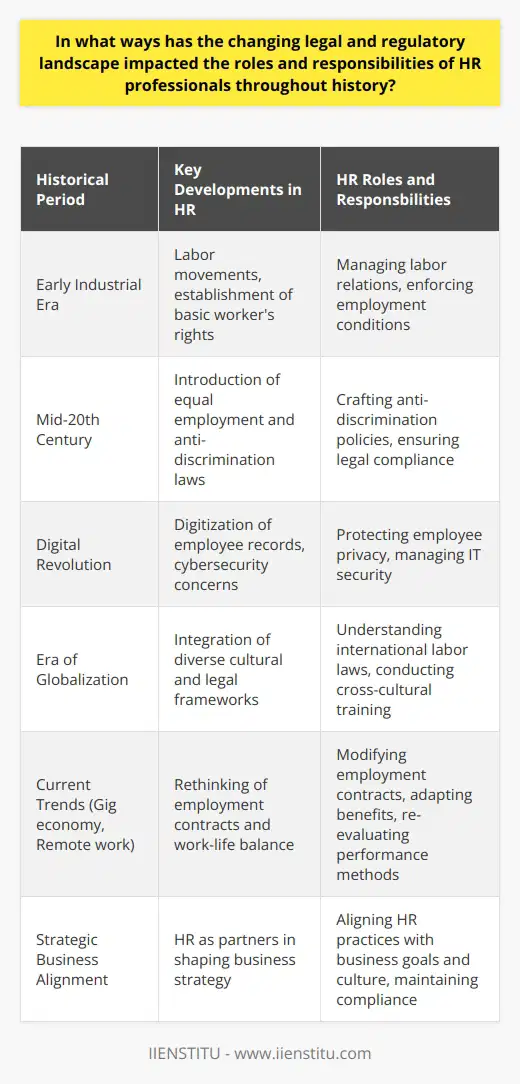
What is the evolution of HRM history?
Historical Development of HRM
The evolution of Human Resource Management (HRM) can be traced back to the late 19th and early 20th centuries. Initially, its primary function was to maintain records, ensure legal compliance, and deal with administrative tasks, with little focus on employee development and engagement. The early years of HRM were marked by the emergence of welfare and personnel management departments, which had the primary responsibility of taking care of employee welfare concerns.
Post-WWII Developments
After World War II, the focus of HRM shifted from merely addressing employee welfare to an approach that emphasized the importance of human relations and collaboration. This phase of HRM evolution marked the beginning of the Hawthorne Studies, which showcased the influence of social and psychological factors on employee productivity and workplace dynamics. Consequently, HRM evolved to incorporate a more humanistic approach, concerned with employee satisfaction, motivation, and overall organizational development.
The Emergence of Strategic HRM
The 1980s brought a key change in the HRM landscape, with increasing adoption of the strategic human resource management (SHRM) approach. This shift emphasized the alignment of HRM with business objectives, recognizing the significant role of human capital in organizational success. HRM's focus now included manpower planning, talent acquisition, performance management, and employee development, with an emphasis on fostering a culture that supports business growth and competitiveness.
Advancements in Technology and Globalization
The 1990s and early 21st century witnessed rapid advancements in technology, which had a profound impact on HRM. The automation of routine HR tasks, use of analytics in decision-making, and the adoption of digitized platforms have transformed HRM into a data-driven function. Additionally, the process of globalization led to an increased demand for talent management, diversified workforce, and cross-cultural understanding. HRM evolved to meet these emerging challenges, and its role expanded to include talent management, knowledge management, and change management.
Conclusion
Looking back at the HRM history, we observe a significant shift in the role of HRM in organizations from being an administrative function to a strategic partner. Today, HRM is integral to organizational success, driving performance through effective talent management, employee development, and engagement strategies. HRM evolution has been marked by periodic transitions, driven by economic, social, and technological factors, shaping HRM as a critical function that continuously adapts to meet the ever-evolving needs of businesses and employees.
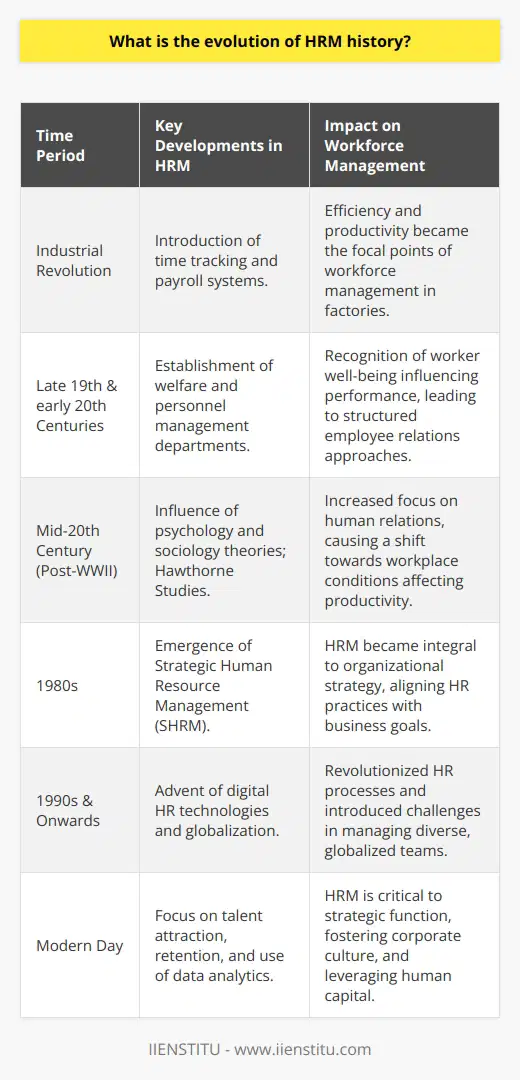
How has HRM evolved over the past?
Historical Transformation of HRM
Human Resource Management (HRM) has evolved significantly over time, transitioning from a primarily administrative function to a more strategic and integrated approach in modern organizations. Initially, HRM's primary focus was on managing personnel activities such as recruitment, selection, compensation, and training. However, as organizations faced increased globalization and competition, the need for a proactive approach to manage talent and resources became more apparent.
Shift in Focus and Approach
The emergence of the behavioral sciences in the 1960s and 70s brought attention to the importance of employee motivation, satisfaction, and performance, leading to the development of the human relations movement. This shift in focus required HR professionals to possess skills and knowledge beyond the traditional administrative areas. The 1980s and 90s saw the emergence of strategic HRM, which linked the organization's goals and objectives with the management of human resources. These changes required HR professionals to play a more proactive and strategic role in developing policies and practices to attract, retain, and develop the right talent.
Technological Advancements
Technological advancements have also played a significant role in HRM's evolution by automating routine administrative tasks and enhancing the communication between HR professionals, employees, and managers. The introduction of Human Resource Information Systems (HRIS) and HR software enabled the HR function to be more efficient and data-driven. Additionally, technology-enabled advancements in Machine Learning and AI have further led to the development of recruitment, learning, and performance management analytics.
Relevance of Workplace Diversity
HRM has also evolved in response to changes in workforce demographics and the increasing emphasis on workplace diversity. With globalization and migrations, workforces have become more diverse in terms of gender, ethnicity, culture, and other factors. Consequently, HR professionals have had to develop strategies for managing diversity, including fostering inclusive work environments, addressing unconscious bias, and ensuring equal opportunities for all employees.
Focus on Employee Well-being
The significance of employee well-being and work-life balance has gained more prominence in recent years. HRM practices have evolved to prioritize employees' psychological and emotional needs, emphasizing the value of employee engagement, wellness programs, and flexible working arrangements. As a result, HR is now tasked with creating a positive organizational culture that supports the well-being of employees, leading to higher levels of organizational commitment and productivity.
In conclusion, HRM has evolved considerably over time to cater to an increasingly global, diverse, and technologically advanced workforce. This evolution has transformed the HR function from its traditional administrative role to a more strategic and proactive one, addressing the challenges of the contemporary business environment and contributing to organizational success.
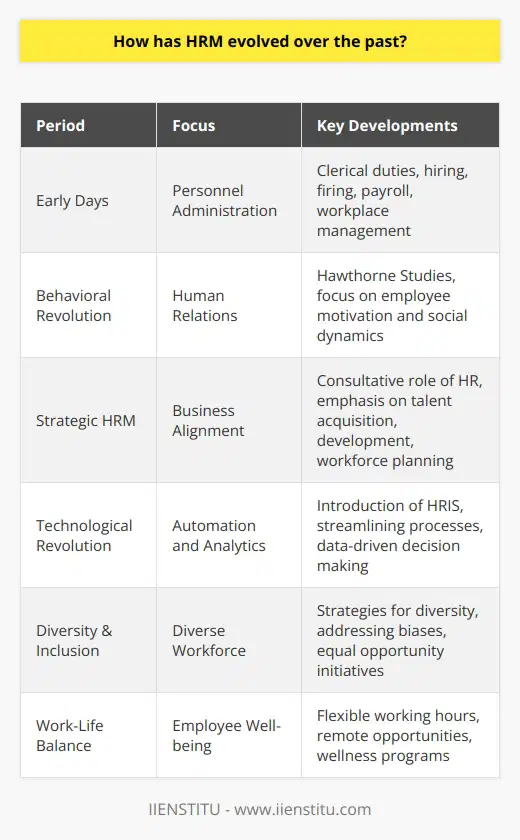
How has the role of HR changed over the years?
Evolution of HR Practices
Historically, Human Resources (HR) began as a primarily administrative function overseeing employee records, payroll, and benefits. The focus was on ensuring compliance with labor laws and maintaining organizational stability. Over the years, however, the role of HR has expanded and evolved, responding to changes in society, technology, and the demands of the business environment.
Transformation into Strategic Partner
In recent decades, HR has progressed to becoming a strategic partner within organizations. This transformative shift is due to businesses recognizing that, to achieve success, they must tap into their most valuable resource: their employees. HR now plays a crucial role in aligning workforce goals with business objectives, enabling organizations to maximize employee performance and engagement.
Talent Management and Development
As a modern strategic partner, HR emphasizes talent management and development. This evolution is driven by the increasingly competitive business landscape, as companies strive to attract, retain, and develop top talent capable of promoting organizational growth. HR professionals are at the forefront of identifying skill gaps, selecting appropriate training initiatives, and fostering a culture of continuous development.
Employee Experience Enhancement
Additionally, HR has shifted towards prioritizing employee experiences and satisfaction. Research has demonstrated the correlation between employee engagement and overall productivity, prompting HR to invest in tailored onboarding processes, competitive benefits packages, and fostering a positive work environment. Facilitating employee feedback and open dialogue is also a vital component of the contemporary HR role.
Embracing Technological Advances
Another key factor that has changed the role of HR is the emergence of technology, affecting all aspects of work. From recruitment and selection to performance management, HR professionals must leverage digital tools to streamline processes, gather data, and analyze trends. In effect, technology has allowed HR to become more efficient and make informed decisions based on data-driven insights.
In conclusion, the role of HR has evolved significantly in response to the changing needs of organizations and advancements in technology. From a previously administrative-centric function, HR has emerged as a strategic partner responsible for shaping workforce strategy, fostering talent development, enhancing the employee experience, and leveraging technological innovations. The continuous adaptation of HR will remain a vital driver of success in the modern business world.
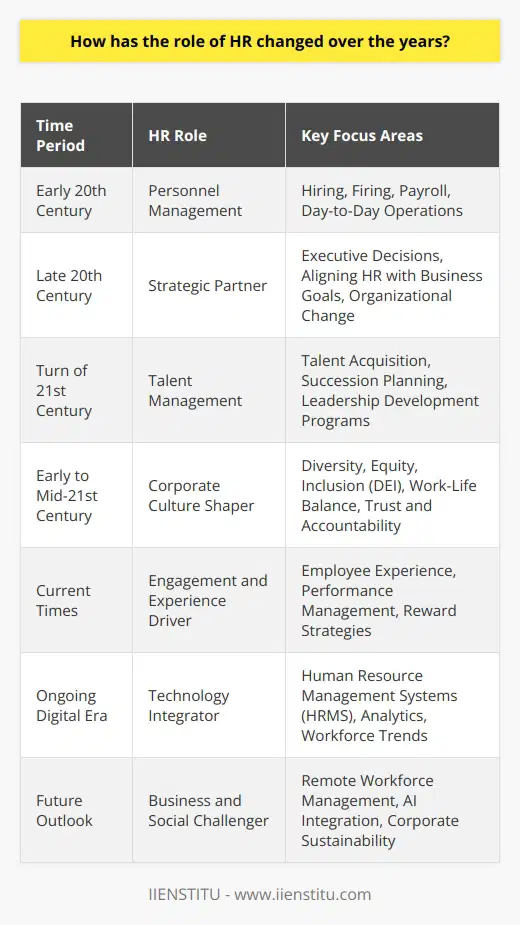
What is the historical evolution of HRM?
Historical Evolution of HRM
Origins in Industrial Revolution
The historical evolution of Human Resource Management (HRM) can be traced back to the Industrial Revolution of the late 18th and early 19th centuries. During this period, there was a shift from agricultural to manufacturing industries, leading to an increased need for managing labor forces effectively.
Introduction of Personnel Management
In the early 20th century, HRM evolved into personnel management, focusing on recruitment, selection, and compensation of employees. The primary objective of personnel management was to maximize efficiency and productivity while ensuring employees were treated fairly.
Influence of Scientific Management
The emergence of scientific management in the 1920s aided the evolution of HRM by emphasizing the need for a systematic approach to managing human resources. Frederick Taylor, a pioneer of scientific management, advocated for the implementation of standardized procedures and employee training to increase efficiency.
Impact of Hawthorne Studies
The Hawthorne Studies conducted in the late 1920s and early 1930s dramatically changed the perspective on human resources management. The studies revealed the significance of employee satisfaction, motivation, and interpersonal relationships, shifting the focus from merely maximizing productivity to fostering employee well-being.
Evolution Towards HRM
The post-World War II period saw the growth of multinational corporations and increased international competition, necessitating a more strategic approach to human resource management. HRM began to gain more importance in organizational decision-making, focusing on aligning human resource practices with organizational goals.
Integration with Organizational Strategy
By the 1980s, HRM had become an integral part of organizational strategy, with an emphasis on employee performance and the acquisition of skills relevant to the organization's needs. The role of HR professionals expanded to encompass strategic planning, training, and development, as well as managing workplace diversity.
Current Trends and Future Challenges
In the 21st century, HRM has continued to evolve alongside technological advancements and changes in the global workforce. This has led to increased focus on flexible work arrangements, digitalization of HR processes, workforce analytics, and employee engagement.
In conclusion, the historical evolution of HRM reflects a shift from a mere focus on productivity and efficiency to a more strategic and people-oriented approach, emphasizing the importance of employee satisfaction and aligning human resource practices with organizational goals. Today's HRM professionals must adapt to the rapid technological advancements and the dynamic nature of the global workforce to effectively manage human resources and contribute to organizational success.
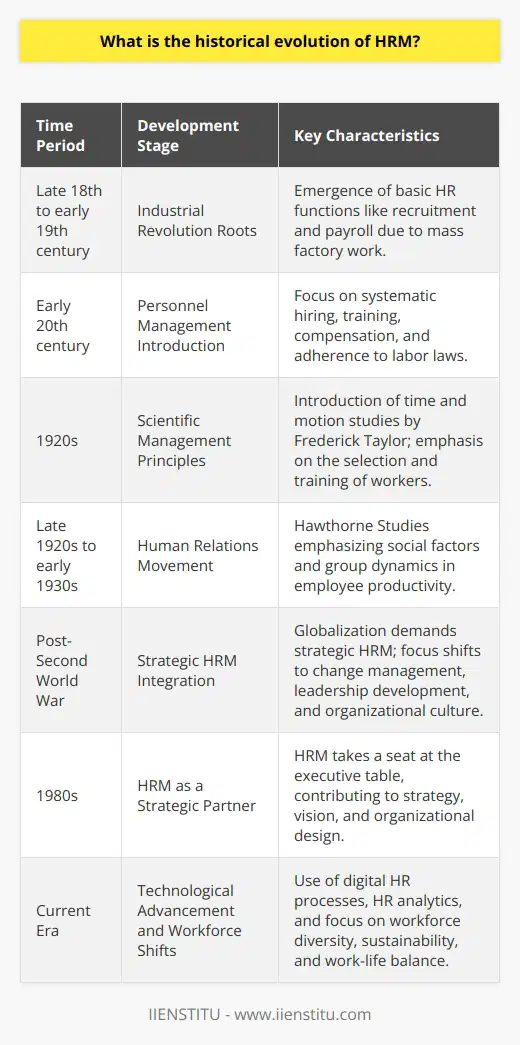
How has the role of HR changed over the years?
Evolution of HR Functions
The role of HR has evolved significantly over the years, transitioning from an administrative function to a strategic partner within organizations. Initially, HR predominantly focused on tasks such as payroll administration, employee relations, and record-keeping. However, rapid advancements in technology, globalization, and changing workforce dynamics have introduced a paradigm shift in HR's role and responsibilities.
Strategic Planning
As organizations strive to stay competitive, HR now actively participates in strategic planning, working alongside management to identify, develop, and retain top talent. HR professionals contribute to organizational success by recommending appropriate talent management strategies, building a diverse and inclusive workforce, and fostering a culture that promotes employee engagement and motivation.
Technology Integration
The integration of HR technology has significantly influenced how HR functions are managed. The adoption of advanced systems and tools, such as HRIS, ATS, and LMS, has streamlined processes, enabling HR to efficiently manage employee data, recruitment, training, performance evaluations, and compliance.
Role in Workforce Analytics
HR has also taken a central role in analyzing workforce data, identifying trends and patterns related to employee performance, productivity, and attrition. This data-driven approach allows HR to provide management with insights and make evidence-based recommendations to improve organizational performance and enhance employee satisfaction.
Focus on Employee Well-being
The domain of HR has expanded to ensure the overall well-being of employees. HR professionals now emphasize employee mental and physical health through initiatives such as wellness programs, work-life balance, and stress management. Addressing employee well-being fosters a healthy, engaged, and productive workforce.
Legal and Regulatory Considerations
As the employment landscape becomes more complex and regulated, HR plays a critical role in helping organizations navigate various legal and regulatory requirements. In-depth knowledge of labor laws, employment standards, and workplace policies has become crucial for HR practitioners to maintain compliance and mitigate potential risks.
Talent Development
Apart from the recruitment function, HR now substantially focuses on nurturing and developing employees by providing continuous learning and development opportunities. Implementation of comprehensive training programs, mentorship initiatives, and succession planning strategies are now core responsibilities for HR professionals to ensure the organization's talent pipeline and future leadership is secure.
In conclusion, the role of HR has evolved from merely handling administrative tasks to actively participating in organizational growth and development. By adapting to technological advances, embracing data-driven decision-making, and prioritizing employee well-being, HR has become an indispensable partner to management in shaping the future of organizations.

What are the 5 stages of evolution of HRM?
Stages of HRM Evolution: Overview
The evolution of Human Resource Management (HRM) can be understood through the examination of five distinct stages. These stages represent the shift from a purely administrative function to a strategic role that focuses on employee engagement and organizational success.
Stage 1: Personnel Management
In the early stages, HRM was primarily focused on personnel management. This involved the recruitment, selection, and training of employees, as well as maintaining records and ensuring compliance with labor laws. The main focus was on hiring and managing a skilled workforce but lacked broader strategic planning.
Stage 2: Industrial Relations
As industrialization progressed, the focus shifted towards managing relationships between employers and employees. In this stage, the role of HRM broadened to encompass union negotiation, arbitration of disputes, and ensuring compliance with collective bargaining agreements. HR professionals now focused on fostering better communication and maintaining harmonious relationships within the workplace.
Stage 3: Organizational Development
The next stage in the evolution of HRM saw a growing recognition of the importance of human capital for organizational success. Organizational development efforts aimed at enhancing overall performance, and HRM professionals began to focus on strategic planning, employee development, performance management, and succession planning. Their roles became increasingly connected to critical business objectives.
Stage 4: Human Capital Management
As organizations acknowledged the significance of human capital in driving performance, HRM evolved into human capital management (HCM). In this stage, HR professionals developed strategic frameworks to better align talent acquisition, retention, and development with organizational goals. The focus shifted from transactional to transformational activities, such as change management and leadership development.
Stage 5: Strategic HRM
The current stage of HRM evolution is marked by a shift towards a more comprehensive strategic approach. HR professionals collaborate closely with senior leadership to contribute to organizational success through workforce planning, talent management, and the creation of a competitive advantage. Key components of strategic HRM include cultural and organizational alignment, employee engagement, and data-driven decision-making.
Conclusion
The evolution of HRM has progressed through five distinct stages, from basic personnel management to a strategic role that emphasizes employee engagement, organizational alignment, and data-driven decision-making. Today, HR professionals play a critical part in shaping the success and competitiveness of organizations by managing human capital effectively and strategically.

What are the key factors that led to the transformation of personnel management into human resource management?
Driving Forces Behind the Transformation
The transformation of personnel management into human resource management came as a result of a few key factors. These factors have created a profound shift in the way organizations view and manage their workforce.
Economic Pressures
Firstly, the increasing pressure of globalisation and economic competitiveness pushed organizations to rethink their approach. They needed to manage their employees not merely as 'workers,' but as valuable resources. Therefore, the concept of 'human resources' was born out of the necessity for businesses to stay competitive.
Technology Advancements
Secondly, the advent of technology and the growth of data analysis brought about a more strategic approach. Assessments that used to take months to compile could now be done in seconds. Consequently, human resource management became a more strategic function within organizations.
Evolution in Organizational Culture
Thirdly, changes in organisational culture also played a crucial role in the shift. This cultural shift placed more emphasis on employee engagement and satisfaction. As such, human resource departments had to adapt by implementing programs to stimulate employee development and wellbeing.
Legal Framework Adjustments
Finally, changes in the legal framework surrounding employment also contributed to the transformation. Out of necessity, personnel managers had to become more adept at navigating a complex legal landscape. As a result, human resource management became a profession in its own right, complete with legal and ethical standards.
In conclusion, economic pressures, technological advancements, changes in organizational culture, and adjustments to the legal framework were instrumental in transforming personnel management into human resource management. This transition allowed companies to view their workers as a valuable resource, leading to more strategic approaches towards employee management.

How have the roles of HR practitioners evolved in response to shifts in economic, political, and social contexts throughout history?
Changing Economic Context and HR Evolution
The roles of HR practitioners have evolved significantly due to economic shifts throughout history. In the 19th century, most companies were small, and HR roles were informal. With the advent of industrialization, companies grew and developed complex structures. HR's role then was to maintain an orderly workforce and handle administration tasks.
Role Expansion due to Political Landscape Shift
Political contexts have also led to HR evolution. In the mid-20th century, new labor laws were enacted, requiring HR to ensure compliance and protect employer interests. The civil rights era further expanded HR's role to include diversity training and ensuring equal employment.
Globalization and HR Adaptation
Globalization has also played a significant role in transforming HR. The need for a diverse workforce and an understanding of cultural nuances has led HR to develop training programs and inclusive hiring policies.
Adapting to Social Contexts
Social contexts have played a significant part in redefining HR roles. The rise of the knowledge economy and increased employee expectations for work-life balance have led HR to focus more on talent management, performance optimization, and employee satisfaction.
The Technological Impact on HR
Technological advancements have significantly changed HR roles. Digital transformation and the rise of remote work necessitate HR professionals to harness technology for effective recruitment, training, and engagement.
Overall, HR's role has transitioned from administrative to strategic. This evolution reflects the HRM's response to shifts in the economic, political, social, and technological landscapes, prompting them to ensure a productive, diversified, fairly treated, and technologically adept workforce.
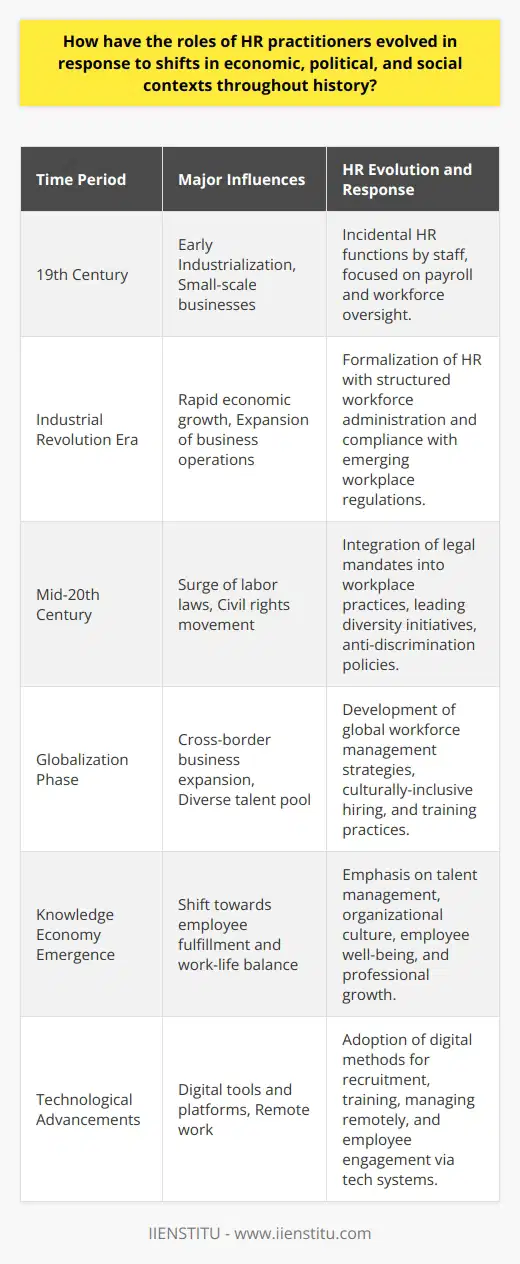
Can you identify and explain the major turning points in the development of human resource management theory and its practical applications?
Early Theories and Models
Human resource management (HRM) theory has its origins in the Industrial Revolution. Workers were seen as inputs in production processes. This view changed with the human relations movement, which stressed the importance of considering human factors in managing employees.
Development of Humanist Theories
Theories of motivation like Maslow's hierarchy of needs and Herzberg's two-factor theory marked significant turning points. They highlighted the role of intrinsic motivation and the need for a respectful, satisfying work environment.
Systems Approach and Contingency Theory
Another leap came with the systems approach, viewing the organization as a whole. The contingency theory followed, arguing that HRM practices should fit the specific context of an organization. These theories emphasized the importance of flexibility in HRM.
Strategic HRM
The strategic human resource management theory emerged next, proposing that HRM should align with the organization's strategy. This model underlined the strategic importance of HRM in achieving organizational goals.
HRM and Globalization
The last major shift in HRM theory recognizes the impact of globalization. It suggests that HRM practices must be adaptable to diverse cultural contexts. This development highlights understanding and respecting cultural differences in the workplace.
Practical Applications
Each of these theoretical developments has led to changes in HRM practices. For example, humanist theories have influenced job design, work-life balance policies, and workplace wellbeing initiatives. Strategic HRM has resulted in HR becoming a key player in organizational strategy, while the latest theory has guided companies in managing multicultural workforces.
In summary, the development of HRM theory has experienced several key turning points. Each one has influenced HRM practices, contributing to more effective management of human resources.
